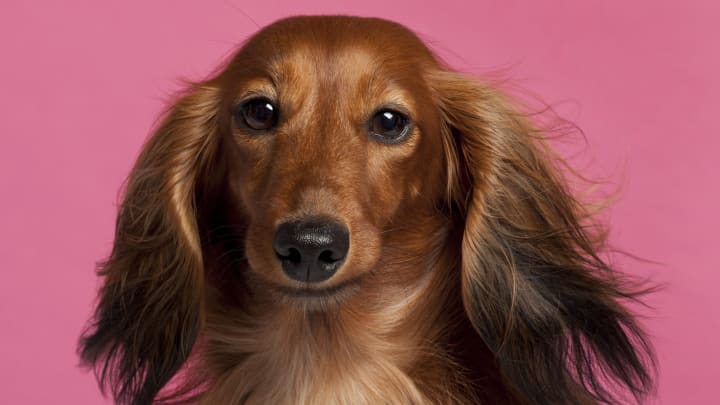9 Short Facts About Dachshunds

Dachshunds are tiny, but they were bred to do some pretty big jobs. Here’s the lowdown on everyone’s favorite vertically challenged dog.
1. Dachshunds are fierce.
The little dogs were bred 300 years ago in Germany to hunt badgers—their name literally means “badger hound” (dachs means badger; hund means dog). Their short legs allow them to enter badger dens, and their fierce gusto gives them the courage to take on the 15-pound mammals.
2. They come in a wide variety of sizes and colors.
According to the American Kennel Club, dachshunds come in several standard colors and exhibit different kinds of markings; some interesting colors include blue and tan, cream, and wild boar, a mixture of brown and gold. Their coats can be smooth, long, or wire-haired. They come in two sizes: standard and miniature.
3. Anti-Germany hysteria led to a temporary name change.
Before there were freedom fries, there was the freedom pup. Thanks to their German heritage, during World War I dachshunds were often used to portray Germany in propaganda. Although often humorous, these ads led to a widespread contempt for the breed. The American Kennel Club tried to rebrand the breed by renaming them “badger dogs,” while others referred to them as “liberty pups.”
Unfortunately, this didn’t do much to help the breed’s wartime image. Kaiser Wilhelm II was known for his love of doxies and actually had his five pets buried at the Huis Doorn park. Two of his poorly behaved dachshunds, Wadl and Hexl, had previously made headlines after attacking Archduke Franz Ferdinand’s prized golden pheasants during a visit.
4. The Nazis claimed they taught a dachshund to speak.
If World War I was tough on dachshunds, what came next was just weird. Nazi scientists boasted that they successfully taught the dogs to speak, read, spell, and even communicate telepathically. Germans believed that dogs were nearly as intelligent as humans, so they set up a special program called Hundesprechschule Asra to tap into that asset. Some of the outlandish feats claimed by the program included a dog that could say “mein Fuhrer” and another that could write poetry.
Kurwenal was a dachshund that could “speak” with different numbers of barks for different letters—sort of like a canine telegraph. According to Jan Bondeson's book, Amazing Dogs: A Cabinet of Canine Curiosities, the dog even had his own biographer detailing the pup's daily life. He reportedly liked pink roses, illustrated zoology books, and attractive women. When asked if he ever wanted to be a father, the bachelor declared, “No!” Many were impressed with the fat little dog’s routine, but others suspected that he was receiving cues from his owners.
Right before he passed away, Kurwenal poetically barked, “I am not afraid of dying; dogs have souls and they are like the souls of men." The dachshund was buried in the garden of his owner’s home.
5. They’ve made a comeback.
Despite this rocky period, the resilient breed weathered two World Wars and has been welcomed back into the hearts of Americans thanks to some serious PR work. Today, dachshunds are the 10th most popular breed in America.
6. The first Olympic mascot was a dachshund.
The idea for Waldi the dachshund was hatched during the 1972 Munich games’ organizing committee’s Christmas party in 1969. Attendees used crayons and modeling clay to create a mascot. Dachshunds are known for their athleticism and courage, so the colorful dog seemed like the perfect face for the Olympics.
7. Artists love dachshunds.
Famous artists have seemed to be drawn to the little dogs. Andy Warhol would often bring his doxie to interviews and let the dog “answer” the questions he didn’t like. When Picasso met David Douglas Duncan’s dachshund, Lump, in 1957, it was love at first sight. Their relationship was chronicled in Duncan’s Picasso and Lump: A Dachshund's Odyssey.
David Hockney was another dachshund aficionado. His two dogs, Stanley and Boodgie, were featured in 45 oil paintings and a whole book. The Far Side creator Gary Larson even used the dogs for a parody book called Wiener Dog Art: A Far Side Collection—a whole collection of classic art pieces with dachshunds added in for comedic effect.
8. The hot dog was named after the breed.
The history of hot dogs is murky at best, but some historians believe that they were first known as "dachshund sausages," after the similarly shaped dogs, which were favorite companions of German butchers. Some suggest that the name was changed after one cartoonist had trouble spelling “dachshund” and shortened it. Unfortunately, no one can find the comic, so the theory has been dismissed as apocryphal. The earliest written record of the phrase "hot dog" can be traced to an 1895 issue of the Yale Record about a lunch cart serving hot dogs to hungry students.
9. A dachshund is Britain’s first cloned dog.
After winning a contest, dog owner Rebecca Smith from Battersea had her 12-year-old dachshund, Winnie, cloned. Experts in South Korea cared for the puppy for five months before sending her home to Smith. Despite the difference in age, the resemblance is striking; they both have a crooked tail and the same markings. The clone—dubbed Mini-Winnie—had her own puppies in 2018.
A version of this story originally ran in 2015; it has been updated for 2022.